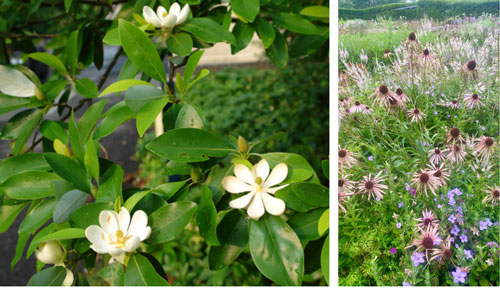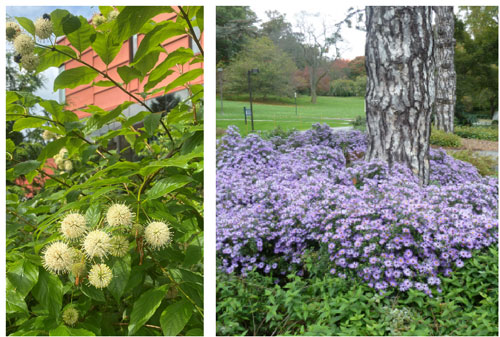7/1/2024
Eco-Friendly Gardens
Andrew Bunting

With climate change becoming a bigger challenge for gardeners across the country, more and more are looking to help support local wildlife and pollinators through creating an ecologically functional garden. Thankfully, there are many things you can do to create ecological-friendly habitats in your home garden.
Pictured: An excellent plant for rain gardens is Magnolia virginiana var. australis. • Echinacea pallida is one of several plants that can offer seeds for birds like native sparrows and American Goldfinch.
One strategy is to create gardens that attract myriad native pollinators, including native bees, wasps, moths, butterflies, beetles and even birds, such as the Ruby-throated hummingbird. The endangered Monarch butterfly can be attracted to the garden by providing a source of pollen. This can be achieved by including many species of native milkweed, including the butterfly milkweed, Asclepias tuberosa, and the common milkweed, Asclepias syriaca.
Other great pollinator plants include any of the mountain mints, especially Pycnanthemum muticum; native asters (Symphyotrichum oblongifolium); coneflowers (Echinacea purpurea); Golden Alexander (Zizia aurea); and shrubs such as New Jersey Tea (Ceanothus americanus) and buttonbush (Cephalanthus occidentalis).
Helping Wildlife
To create and preserve these habitats for your pollinators in the summer, it’s important to have a water source. This can be as simple as a low dish that can hold some water or some sort of natural object that can do the same. During winter, it’s important to be mindful of creating an appropriate habitat for pollinating insects to overwinter. It’s recommended to “leave the leaves,” whereby leaves are left as a natural mulch and not removed in the fall. Additionally, perennials shouldn’t be cut back in the fall because the debris and even the hollow stems of the perennial provide the perfect overwintering habitat for pollinating insects.
 It’s also important to create a food source for both resident and migrating birds. Many of the native fruiting shrubs and trees are great for a variety of birds, including the flowering dogwood (Cornus florida); arrowwood viburnum (Viburnum dentatum); red chokeberry (Aronia arbutifolia); and the northern bayberry (Myrica pensylvanica). Many of the seed-eating birds like native sparrows and the American Goldfinch can be supported by seed sources, including the giant coneflower (Rudbeckia maxima); black-eyed Susan (Rudbeckia fulgida and Rudbeckia hirta); and coneflowers (Echinacea purpurea, E. pallida, E. paradoxa and E. tennesseensis).
It’s also important to create a food source for both resident and migrating birds. Many of the native fruiting shrubs and trees are great for a variety of birds, including the flowering dogwood (Cornus florida); arrowwood viburnum (Viburnum dentatum); red chokeberry (Aronia arbutifolia); and the northern bayberry (Myrica pensylvanica). Many of the seed-eating birds like native sparrows and the American Goldfinch can be supported by seed sources, including the giant coneflower (Rudbeckia maxima); black-eyed Susan (Rudbeckia fulgida and Rudbeckia hirta); and coneflowers (Echinacea purpurea, E. pallida, E. paradoxa and E. tennesseensis).
Pictured: Cephalanthus occidentalis is one that can be added to a rain
garden to capture stormwater runoff. • This spray of Symphyotrichum oblongifolium at Scott Arboretum is sure to attract native pollinators.
Addressing Stormwater Runoff
With changing weather patterns, especially due to global climate change, natural water systems and drainage systems alike are becoming inundated with stormwater runoff. In addition to designing a pollinator-friendly garden, there are several tactics that homeowners can employ to mitigate stormwater. The simplest approach is to plant trees. Trees are constantly absorbing moisture and are proven to help with the reduction of stormwater runoff.
Creating a rain garden is another way to capture stormwater from gutters on houses or general runoff after a storm. Creating a depressed basin-like area in the garden helps to capture the water and hold it until it can soak back into the ground. Rain gardens are often planted with plants that can withstand highly saturated soils like the winterberry holly (Ilex verticillata); buttonbush (Cephalanthus occidentalis); sweetbay magnolia (Magnolia virginiana var. australis); and several perennials, including the swamp milkweed (Asclepias incarnata); and cardinal flower (Lobelia cardinalis).
Additionally, rain barrels can be added to the downspouts on houses. This diverts the water from potentially going into a stormwater system and instead collects it in the rain barrel. Rain barrels often have a faucet or spigot at the bottom of the barrel so that watering cans can be subsequently filled and the rainwater can be used to water the garden.
Addressing Drought Conditions
Another climate change challenge many gardeners are facing is extended periods of drought. The deep-rooted flowering perennials and grasses of the midwestern prairies lend themselves to being outstanding plants for withstanding drought-like conditions.
Garden Designer Jeff Epping, who’s often called the “gravel guru,” uses the little bluestem (Schizachyrium scoparium) in his designs. As the name would suggest, the strict upright foliage is blue, but can also have hints of pink and red. Turning orange-red in the fall, it’ll also maintain its form for most of the winter.
Larger in stature is a selection on the big bluestem (Andropogon gerardii Blackhawks). This native grass reaches 4-ft. tall and has attractive upright leaves that are a deep purple. Both schizachyrium and andropogon combine well with flowering perennials such as baptisia, amsonia, parthenium and milkweeds.
There are many native flowering plants that were selected from the prairies and therefore also drought tolerant. Perhaps most notably are selections and hybrids of the deep rooted Baptisia australis. To say that this has had an amazing renaissance in the garden would be an understatement. Many plant breeders have done amazing work to advance this genus.
In mid-spring, often towering about the foliage, are erect stems covered in pea-like flowers. The Chicago Botanic Garden has done extensive trials and evaluations on baptisia over the last 30 years and they recommend Lemon Meringue with clear yellow flowers; the blue flowered Blueberry Sundae; Cherries Jubilee with bicolor flowers of burgundy and yellow; and the soft blue flowers of Lunar Eclipse. The flowers are often followed by black pods that will rattle in the wind and provide late-season interest.
There are a handful of outstanding trees that are tolerant of drought and are resilient to difficult urban conditions as well. At the Pennsylvania Horticultural Society, we promote two native oaks, including the swamp white oak (Quercus bicolor) and the bur oak (Quercus macrocarpa). Both species have a broad native range. They have a picturesque habit as they mature and yellow to golden fall foliage. Both have proven to be “urban tough.”
Additionally, used throughout the Midwest and the east is the Kentucky Coffeetree (Gymnocladus dioicus). In its youth, it can be a bit gangly and awkward, but over time, it develops an architectural upright canopy. The large compound leaves have small leaflets to create light shade. The female trees can produce a stout pod, which can be messy, so a male selection such as Espresso is recommended.
Ecological approaches to gardening help to mitigate severe weather patterns that will cause mass inundation of rain, as well as extreme periods of drought. These approaches also help to create habitat in the garden to attract pollinators, beneficial insects and native birds, so you can do good for the environment and local biodiversity, while also designing a beautiful garden sure to provide interest all year round. GP
Andrew Bunting is the Vice President of Horticulture for the Pennsylvania Horticultural Society (PHS), which uses horticulture to advance the health and well-being of the Greater Philadelphia region. To learn more about PHS, or to become a member and support greening initiatives in over 250 neighborhoods, visit PHSonline.org.